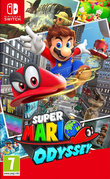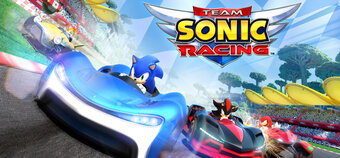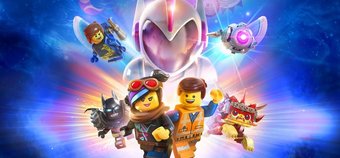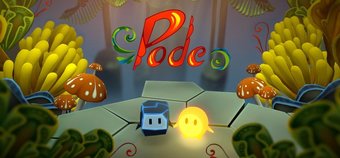Mario really is magic. Ever since the very first game broke new ground some 22 years ago, there's always been something special about picking up a new Mario game for the first time, as all the pieces slot effortlessly into place - and Odyssey is no different. No matter what crap you've had going on in your life, no matter how glum you may be feeling, a few minutes with Mario is all it takes to put a smile on your face for the rest of the day. We still aren't sure quite what does it - it's a magic that few games seem to replicate - but even after all these years, Mario still has that midas touch (his sacrilegious iPhone outing notwithstanding).
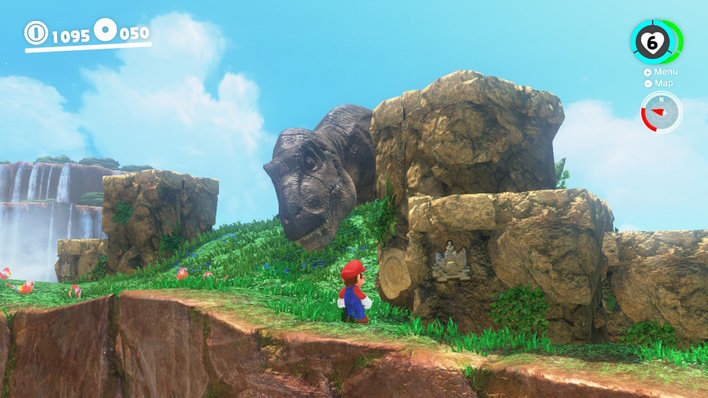
A dinosaur. In a Mario game! And check out the fossilised Spikey...
Mario Odyssey, then, is the next "mainline" entry in the Mario series - a 3D platformer with tight, well designed, and open levels that ask you to explore, experiment, and hunt out hundreds of "Moon" collectibles, rather than simply getting from A to B. Designed to follow on from Super Mario 64, Sunshine, and Galaxy, as opposed to the local multiplayer fun of the excellent Super Mario 3D World, it's a different kind of game to the Wii U outing, but one that's every bit as much fun.
With Bowser having kidnapped Princess Peach (stop me if you've heard this one before), it seems the big ol' dino's body clock must be ticking, as rather than simply making off with the lovely Princess, he's decided to marry her. Terrified that his beloved may soon be trapped in the inescapable legal entanglement of eternal matrimony, it's up to good ol' Mazza (that's you) to set off on a quest around the world to try and catch Bowser, and put a stop to his nefarious plan. Only this time, he's not alone.
Perhaps it's a bit dismissive to call it a gimmick, but each Mario game always seems to have something it does that's new, so it can be the very first Mario game to let you do something. From the revolution of analogue joystick control in Super Mario 64, to the FLUDD water cannon in Mario Sunshine, and, er, that thing in Mario Galaxy, Mario's always been a bit of a trendsetter, but the gimmick for Mario Odyssey is perhaps the greatest yet. And the trick? It's all in his hat - or as it's charmingly known, Cappy.
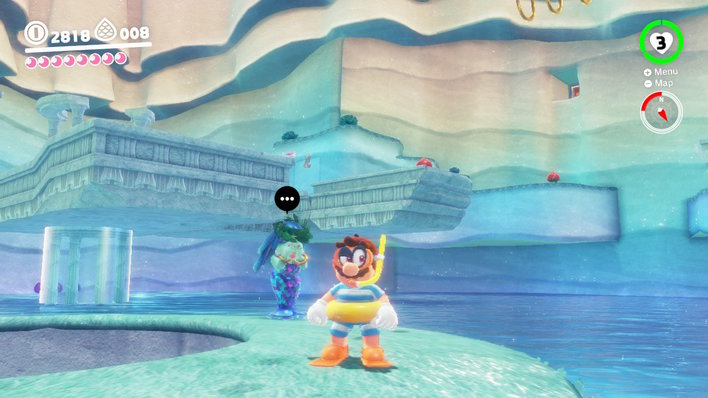
You can actually buy different hats in game, with Cappy transforming into your chosen guise - here he is as a snorkel.
Cappy is actually a resident of the Cap Kingdom, but with his sister having been kidnapped by the dastardly Bowser too, he decides to join forces with Mario, and lend you his phenomenal cosmic powers. Along with adding a cool pair of googly eyes to Mario's cap, Cappy not only lets you interact with the world, smashing boxes, bashing trees, and generally breaking your way through things - but he also lets you take control of things, from enemies to inanimate objects and everything inbetween. From Goombas and cloud riding Lakitus, to space rockets, Christmas trees, and even a flipping t-rex, all you have to do is toss your hat at an enemy to take over their mind. But much more than just being a gimmick, this is actually key to many of the game's puzzles.
As touched on earlier, rather than having a distinct start and end to each level, Mario Odyssey's worlds instead each contain dozens of "Moons" for you to collect. The game's equivalent of stars or shines, there's some 900 (!!) of them to find in the game - and they're a lot of fun to find. While some are left lying around in hard to reach places, many of the others require you to do something very specific in order to find them - often involving taking over another creature/object in the level. Whether you're taking over a Fire Bro to light a campfire, possessing a Cheep Cheep fish to swim through an underwater maze, turning into a zip to open a secret path to a hidden area, or using a stretchy plant thing to lift a platform, there's a huge, huge amount of variety here, and some genuinely fantastic game design.
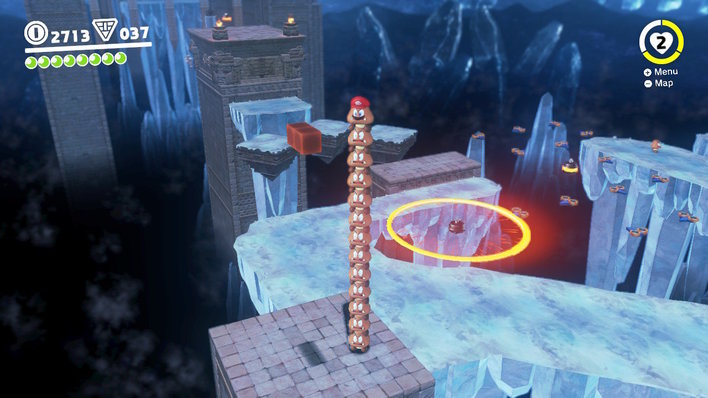
The Goomba's party trick is that you can stack them up tall - we had to collect almost all of them in this level to make a tower big enough to smash those blocks
There's been a lot said about how Mario Odyssey is both a Mario game aimed at the core audience (a phrase which sets alarm bells ringing), and how it's similar in design to Zelda: Breath of the Wild. While these have both been thrown out there by all sorts of commentators and critics, neither are particularly true.
Contrary to what you may have been led to believe, then, the game isn't actually as difficult as you may have heard. While you do only have three heart chunks rather than six, which can lead to one too many premature deaths, Mario Odyssey has clearly been designed to be accessible. Mario himself controls incredibly tightly, with none of the frustrating skiddiness as in other games, while thumbnail sized mini videos will pop up the first time you have to use some of Mario's more elaborate moves. And unlike Zelda: Breath of the Wild, Mario Odyssey is a game that rewards your exploration, rather than punishes it. With tight, well designed levels that are packed full of collectables, you'll never risk heading the wrong way, only to find an impassable mountain in your way, or scale a cliff just for a freak in-game rain shower to get rid of your last 30 minutes of progress as you slide to the bottom of a hill. Instead, Odyssey hits all the rights spots - and keeps hitting them the more you play.
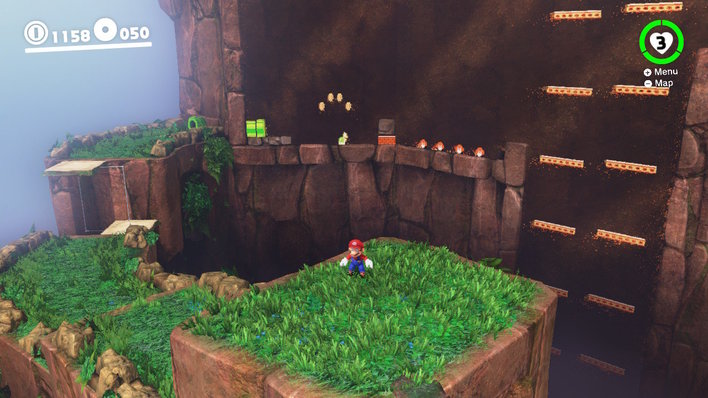
Head through the blocky looking tunnels to switch to old-school 2D mode - with plenty of Moons waiting to be found!
If you ever see a crack in the wall, a ledge way up high, a tunnel you haven't been down, or wonder if you can use X to Y, the chances are, you can, and there'll be a secret waiting for you - and you'll soon develop a keen eye for the telltale signs that hint at an area you want to explore (in particular, keep an eye out for anything - floor, wall, character - that gives off the telltale glow/sparkle of a hidden Moon, and be sure to give it a ground pound/whack). It's this sense of exploration - and how much fun it is - that gives Mario Odyssey its real edge, with each level being absolutely crammed full of hidden secrets, which are incredibly rewarding to seek out.
You aren't entirely left to your own devices, either. The first time you play through each level, you'll have a set of specific objectives that are designed to guide you round and show you the sights, each culminating in a boss fight against one of a family of giant rabbits that seem to be helping Bowser out. While you can stray off the beaten path and go hunting out random Moons from the off if you want, you won't have access to all of a level's Moons until you've beaten the boss at the end of it. And it's not at all necessary to go out and find every last Moon if you don't want to, either. In order to progress to the next level, you'll need to find a small portion of the available Moons in each world - and while that number can vary, it's usually not that many more than you'll get if you just go where you're meant to go, and take on the boss.
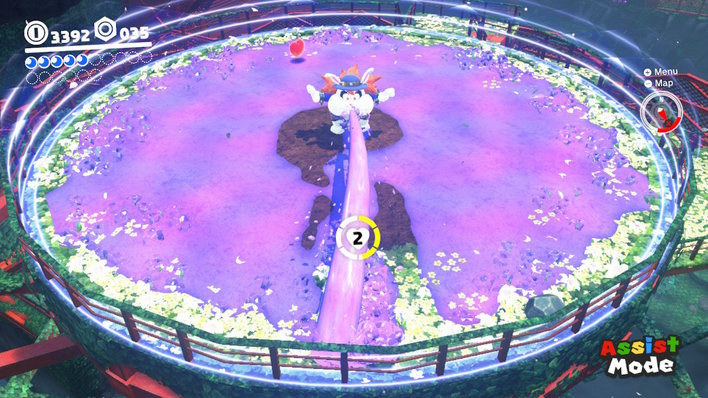
This guy can seemingly fire acidic vomit at you. Nice. Luckily, you can send Cappy in to clear it up.
Of course, you probably won't be able to figure everything out on your own, and so for those who need a little bit of extra help, Odyssey has a few ways of pointing you in the right direction. A random parrot in each location will give you the "name" of one of the moons in that area, which is usually a riddle in and of itself (like "Caught Hopping in the Forest", or "Let's Go Swimming, Captain Toad!"), while a helpful (yet still annoying) Toad will mark a Moon on your map if you're willing to part with 50 coins. It's worth mentioning, too, that there's nothing in the way of micro-transactions or season passes here, either - in a refreshing break from what's become even Nintendo's norms, this is a game designed as it should be: a complete package, all in one. Even if we are a bit miffed at the irritating amiibo points you can find at the start of each level.
That said, Mario Odyssey isn't entirely without a few minor flaws. For one, it continues Nintendo's depressing trend towards having less and less music in its games. While it's a far cry from Breath of the Wild's silent wastelands, there's still pretty substantial amounts of time in game where there'll be no music playing at all - something that feels just wrong for a game that has a great soundtrack when it remembers to play the music it's got.

The underwater level is disappointingly quiet for the most part. Where's the magic of something like this?
On a game design front, there's a few odd choices here too. For one, it seems unusual that the areas where you've already found a Moon will still sparkle and glow as you wonder by, causing many a wasted trip as we try and see if a distant sparkle is a Moon we've already got, or one we've somehow missed. Similarly, the checkpoints here are often quite far apart, and coming a cropper only to find yourself respawning on the other side of the level feels more frustrating than fair, even if you can use the game's handy map to teleport to key points around each level.
Perhaps the biggest issue, though, is the game's use of motion controls. While it doesn't rely on motion controls, there are certain moves in game that can only be performed by flicking one of the Joy-Cons, or shaking them. Of course, there's a bit of a problem with that - what happens if you're playing in handheld mode? Seemingly, Nintendo hadn't really thought of that. You can sit there shaking your whole Switch up and down if you want to jump higher, but trying to perform any of the flick-related moves is awkward at best. If there was a button alternative for these, it wouldn't be that bad, but the only way to perform the vast majority is by shaking - something Nintendo really should have thought about when it designed the game for its hybrid console, especially as a few Moons actually require you to perform the shake-only moves to earn them.
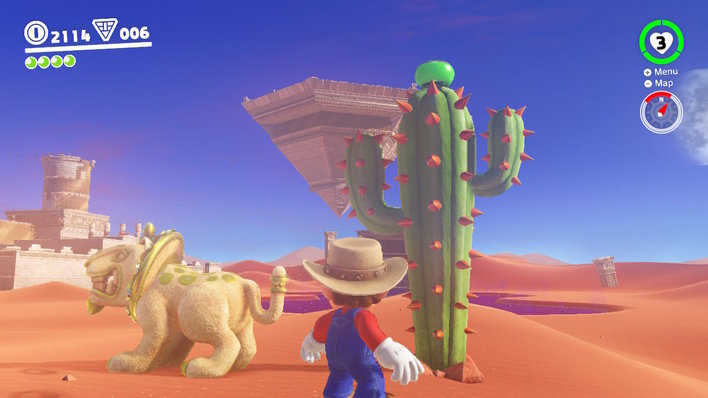
Look out for anything that has this little green bit on top, as that means you can take it over with Cappy.
However, it's not all bad news on the Switch front, as Mario Odyssey also takes advantage of one of the Switch's best features - the fact it essentially has two controllers built in. Letting one player take control of Mario, while the other becomes Cappy, you can play the whole game in a kind of slightly more advanced helper co-op style without the need for any extra controllers. While it's not full blown co-op, this is still a really nice touch, and having a second player control Cappy, and shoot off into the distance to take out any enemies can make the game a lot easier - something which makes it more fun for everyone, but is particularly handy if a parent wants to give their child a helping hand.
In all, then, Mario Odyssey isn't perfect - but this is a game that gets so very much right, it's almost guaranteed to leave you smiling. With some incredibly well designed levels, that "one more go" appeal in bucket loads, and so much of the sort of game design that'll be being taught in textbooks for years to come, Mario Odyssey is pure magic throughout, and the first must-buy physical release on the Switch. This is gaming done as it should be, without a micro-transaction, season pass or DLC add-on in sight - and hopefully, Nintendo will reap the rewards.
Format Reviewed: Nintendo Switch


